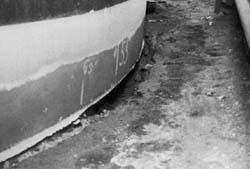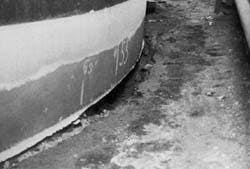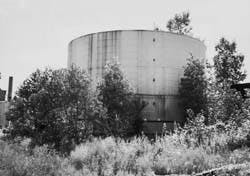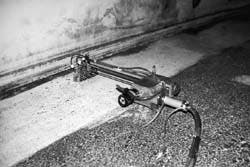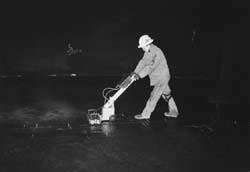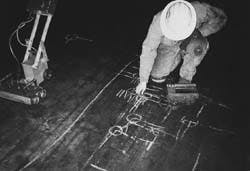Here are guidelines for inspecting AST internals
Steve Caruthers
Tank Consultants Inc.
Tulsa
Despite its wide use, API Standard 653: Tank Inspection, Alteration, and Reconstruction (December 1995) is only a guide for internal inspection of aboveground storage tanks (ASTs) in petroleum products service.
No U.S. federal government regulations cover internal inspection of petroleum product tanks. API-653 is the current industry standard for AST inspection, evaluation, repair, reconstruction, and testing.
Many states, such as Alaska, have incorporated API-653 into their laws for minimum tank maintenance requirements.
Although not a "cookbook" for solving all problems, API-653 does provide a procedure for brittle fracture evaluation. Areas of tanks that do not meet API standards should be evaluated for brittle fracture considerations and also structural integrity.
Brittle fracture considerations are addressed in API-653, Section 3, whose Fig. 3-1 presents a useful decision tree.
Evaluation for structural integrity of areas that do not meet the standard is often case by case and is not well directed.
For instance, a lap-welded shell patch plate could be evaluated by the brittle fracture decision tree and require no repair. Lap-welded plates installed for a piping support or stairway are common and acceptable.
A 24-in. diameter lap-welded plate on the shell that covers a 23.5-in. diameter hole, however, threatens the structural integrity of the tank. Although this type of plate may pass the brittle-fracture decision tree, it should be carefully evaluated.
Bottom cleaning, inspection
The most effective method for preparing tank bottoms for inspection is to brush blast the entire bottom and the lower shell. Although tanks can be cleaned and gas freed without brush blasting, it is the only way to ensure that all pitting and weld corrosion is exposed.
Visual examination of a tank bottom that is not brush blasted has obvious limitations. A plate may look smooth but still have undiscovered pits filled with rust or residue.
Even a magnetic flux exclusion (MFE) cannot detect corrosion within 1-2 in. of fillet welds. Topside pits close to weld seams, therefore, could be missed by visual examination.
It is possible to get a bottom inspected regardless of the cleanliness. If an inspector is told to inspect a tank "as-is," he will normally do so. A good inspector, however, will let you know the limitations of his inspection.
The person performing the formal internal tank inspections is required by API to be an authorized inspector (AI) who must satisfy one of the following experience and education requirements:
- An engineering degree plus 1 year's experience in inspection of tanks, pressure vessels, or piping.
- A 2-year technical certificate and 2 years' experience in inspection of tanks, pressure vessels, or piping.
- A high school education and 3 years' experience in inspection of tanks, pressure vessels, or piping.
- 5 years' experience in inspection of tanks.
Each AI must also pass a 150-question test that covers API-653, API-650, API-651, API-652, API Guide for Inspection of Refinery Equipment (IRE), Chapter XIII, ASME Section X and IX, API IRE Chapter II, and API IRE Chapter XVI.
Until spring 1996, AI's could be certified by experience. This option has expired, however, and all AI's must have passed the test.
To pass the AI test, an applicant must have good reading skills and be able to solve mathematics formulas.
The applicant does not have to be an engineer but it helps. Many people with years of tank-inspection experience are not proficient in analyzing long multiple choice questions that ask "Which one is" or "Which one is not" or "Which is the least acceptable."
It should be recognized that an AI may not have a large amount of tank knowledge even though he may have passed the test.
Contract; inspection
Tank inspections may be bid and contracted on the basis of a lump sum amount, time, and material rates, or a rate per square foot plus travel. Many companies award the tank inspection work to the lowest bidder.
Each company must decide for itself how to select a tank inspection company and how to evaluate experience and technical support.
Contract specifications for API-653 tank inspections should address the following:
- Safety programs and safety records
- Method of bottom inspection: MFE, vacuum box, holiday test. If an MFE is planned, the "threshold" or minimum acceptable remaining wall thickness should be specified.
- Report requirements
- Final report schedule
- Qualifications of the inspector
- Qualifications and the employer of the engineer responsible for the evaluation report.
The normal minimum advance notice for a tank inspection should be 1 week.
Rushing because of schedule changes will occur and must be dealt with. Rushing the inspection contractor, however, should be avoided when possible for obvious reasons.
Inspection forms may be furnished by the contractor or the tank owner or obtained from API-653, Appendix C.
Forms from an experienced inspection contractor are recommended. But even these forms should be reviewed and approved before the work begins. The API-653 Checklist is not recommended as a complete inspection form.
Inspection requirements
An adequate inspection requires attention in the following areas:
An operator may choose, however, whether a clean and isolated tank is a Permit-Required Confined Space or a Non-Permit-Required Confined Space.
Inspection companies should have programs and documentation for safety, drug testing, and training. The field-inspection personnel should have documentation of training.
Exterior tank inspection has turned up bottom sketch-plate deterioration (Fig. 1).Shell. The shell should be completely "as built." All details and dimensions of appurtenances should be recorded. The shell should be examined for coating deterioration, distortion, and corrosion (Fig. 1).
Adequate exterior inspection must not be hindered by excessive vegetation around a tank (Fig. 2).
Inspection of a tank bottom is very important because it will normally determine the interval before the next internal inspection.
A good visual examination of a bottom is necessary no matter what other type of inspection is performed. The visual inspection should include recording the depth of topside pitting. All weld seams should be inspected for excessive corrosion and weld quality.
Spot ultrasonic thickness measurement of all plates is recommended to establish the baseline nominal thicknesses.
A vacuum test of lap welds is optional for uncoated bottoms. This is still the most widely used and simplest method of inspecting bottom lap welds.
An increasingly popular option is a gas or helium test. This involves injecting a gas under the tank bottom, then moving a detector over the bottom to detect gas leaking through the plates or welds.
Testing of the shell-to-bottom weld may be performed by vacuum testing or magnetic-particle examination. Defects are rarely found by these processes.
A recommended practice is to conduct magnetic-particle inspections on only those corner welds in areas of excessive edge settlement.
Bottom coatings may be inspected by holiday testing. This test will detect holes in coatings and should be performed on all bottom coatings before the tank is returned to service.
The holiday test may be performed during the formal internal inspection or after all repair work is completed.
Inspecting the coating initially will allow considering the necessity of replacement along with the repair options for the tank. Inspecting the coating at the end ensures all the original defects and damage from repair contractors are corrected.
Here's an example of an automated ultrasonic bottom-scanning device (Fig. 3).
MFE of tank bottoms
At least six different MFE scanners are available on the market (Fig. 3). These have a variety of magnets, sensors, displays, power supplies, propulsion, colors, etc.; all are expensive.
Some have computers aboard, some have audible alarms, and some rotate. None is fool proof, and none will cover 100% of a tank bottom. None will provide remaining wall thickness of bottom corrosion areas. None is operator independent.
This test is a major advance in tank bottom inspection, but it is not perfect. MFE detects volumes of metal loss in a tank bottom. Small deep pits may give the same response as large shallow pits.
Some scanners will work on bottoms with thick coatings, but even these are very susceptible to the normal variations of thick coatings.
MFE is now widely used for bottom-corrosion inspection, but there are no widely accepted industry standards or guidelines for it.
Following are recommendations for tank owners to ensure a quality MFE scan:
Procedures. Each contractor should develop an MFE procedure that addresses all items listed presently. These procedures should be written in accordance with American Society for Nondestructive Testing (ASNT) SNT-TC-1A.Additionally, the inspection company should have a procedure for the ultrasonic verification of soilside corrosion indications. These procedures should be submitted and approved by the tank owner just as welding procedures should be approved before a repair contractor begins work on a tank.
A qualified operator runs an MFE device over a tank bottom (Fig. 4).
--The contractor should verify with a test plate that his equipment is working satisfactorily. This plate should be of the same thickness as the bottom to be scanned.
It should have adequate metal-removal areas to determine the scanner is working correctly and will detect corrosion metal loss within the desired threshold. --The scanner should initially be set so that areas well above the required threshold will be detected.
After detection and verification of areas on the bottom with remaining metal thickness just above the threshold, the operator should adjust the scanner to a sensitivity that will identify these areas.
It is important during this step that the operator take into account the depth, diameter, and other characteristics of the corroded area.
For these bottoms, ultrasonic readings should be taken at least three places on each sketch plate as close to the corner weld as possible. Any areas with excessive corrosion should be further inspected as necessary to identify all areas below the threshold.
Indications that cannot be verified by ultrasonics should have the coating removed to determine if the metal loss is on the product side. If so, this should be a guide to other indications which cannot be proven up by ultrasonics.
The project engineer should decide how much of the coating to remove for ultrasonic verification based upon spot samples, the condition of the coatings, etc.
MFE scan has indicated soilside metal loss (Fig. 5).
-Threshold (minimum acceptable remaining wall thickness)
-Verification of calibration each day
-Acceptability of the bottom cleanliness
-Acceptability of the bottom warping
-Thickness of the bottom coating
-Acceptability of the bottom coating condition for scanning
-A bottom-plate layout showing the plate numbers, north, and the X, Y axes for indication locations.
-Summary with total indications, total proven up, total soilside indications proven up below the threshold, and total product side indications below the threshold.
-Product-side indications with remaining wall thickness and location; identify those in the critical zone -Soilside indications with remaining wall thickness and location; identify those in the critical zone
-Range of the product-side corrosion pitting where the remaining wall thickness is not below the threshold. This is very important for corrosion analysis and inspection calculations.
A final report, typewritten with a computer drawing of the bottom layout should be sent or faxed within 2 days after the inspection. On-site computer reports are not recommended because of typical site conditions.
Inspection evaluation
The final report should address all deficiencies including brittle fracture, settlement, allowable fill heights, structural integrity, and corrosion analysis.
This report should be written by an engineer with experience in tank design. The report should have a summary with recommendations for corrective action.
Edge settlement should be evaluated in procedures beyond API-653 Appendix B. Better evaluation procedures are available and widely accepted.
API committees are in process of developing a new procedure for edge settlement.
Corrosion analysis of bottoms which have been MFE scanned should be performed by carefully planned procedures. The deterministic method in API-653 is not readily adaptable to scanned bottoms.
The Author
Steve Caruthers is president of Tank Consultants Inc., Tulsa. He is an API-653 Authorized Inspector and has field experience as a field boilermaker and tank maintenance engineer. He currently serves on API committees for API-650 and API-653 standards for new tank construction, repair, and inspection.
Copyright 1996 Oil & Gas Journal. All Rights Reserved.
